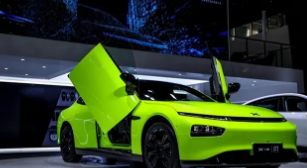- 阅读
- 阅读
- 技巧
- 百科
- 试题
- 文化
- 技能
Science & technology
科技板块
Electric cars
电动汽车
Pump up the voltage!
加大电压

The first EV to use an 800v drive system was the Porsche Taycan, a luxury sports saloon. This was launched in 2019. According to Porsche, by using a fast-charger the Taycan's huge 93kwh battery can, in a little more than five minutes, gather enough juice for the car to travel 100km.
第一款使用800v驱动系统的电动汽车是保时捷Taycan,一款豪华运动轿车。该项目于2019年启动。保时捷称,通过使用快速充电器,Taycan的93kwh巨大电池可以在5分钟多一点的时间内收集足够的电力,使汽车行驶100公里。
Two South Korean producers, Hyundai and its partner Kia, launched their first 800v vehicles this year. Kia says the 77kwh battery in its EV6, which went on sale on August 2nd, can be recharged from 10% to 80% in 18 minutes. (The last 20% of capacity is charged at a slower rate in most EVs, to prevent damage to the battery. Hence a full recharge is typically carried out overnight on a standard charger.) Others have 800v vehicles in the works, too. They include General Motors, Volvo, BYD and Stellantis (a large shareholder in which, for full disclosure, also has a stake in The Economist's parent company).
两家韩国制造商,现代及其合作伙伴起亚,今年推出了他们的第一辆800v电动汽车。起亚表示,8月2日上市的EV6的77kwh电池可以在18分钟内充电10%到80%。(在大多数电动汽车中,为防止对电池造成损坏,最后20%的电量会以较慢的速度充满。因此,一次完整的充电通常会用标准的充电器在夜间进行充电。)其他公司也在生产800v的汽车。这些公司包括通用汽车、沃尔沃、比亚迪和斯特兰提斯(充分披露:该公司的大股东还持有《经济学人》母公司的股份)。
Turning an EV's battery from a 400v to an 800v system is fairly straightforward. Principally, it involves wiring up more of the battery's cells in series. But the associated electronics need additional re-engineering. The main reason why the current generation of EVS use 400v is that semiconductors able to handle higher voltages have not been readily available.
将一辆电动汽车的电池从400v系统转向800v系统相当简单。主要就是将更多的电池单元串联起来,不过相关电子设备需要额外进行重新设计。目前使用400v电动汽车的主要原因是没有能够承受更高电压的半导体。
Now that EV sales are growing strongly, though, specialist chipmakers are investing in semiconductors that can operate at 800v. Instead of using transistors made from pure silicon, those employed by these chips are made from silicon carbide, which is more robust. Safety systems in vehicles, such as automated circuit breakers which isolate the battery in the EVent of a crash, also need to be upgraded.
不过,随着电动汽车销量强劲增长,专业芯片制造商正在投资800伏特的半导体。这些芯片使用的晶体管由更坚固的碳化硅而非纯硅制成。汽车的安全系统,如在发生碰撞时隔离电池的自动断路器,也需要升级。
What all this means is that, as more 800v EVS come onto the market, and batteries continue to improve with increased capacity, more motorists are likely to be persuaded to go electric. Much, however, will depend on the availability of fast-charging infrastructure. If stations are easy to find, and topping up batteries takes only the amount of time required to pick up a coffee, then the malady of range anxiety will at last be laid to rest.
这一切意味着,随着更多的800v电动汽车进入市场,电池容量不断提高,更多的司机可能会被说服选择电动汽车。然而,这在很大程度上取决于快速充电基础设施的可用性。如果充电站随处可见,而给电池充电只需要买一杯咖啡所需的时间,那么“里程焦虑”这一疾病最终将得到缓解。
来源:经济学人
参与评论